
(Queen Millenia art by Paul Sudlow)
The APA has been around in one form or another for a long time - our Founding Fathers used "Committees Of Correspondence" to disseminate information in the heady days of the American Revolution, and your saintly, silver-haired grandma probably sent "round-robin" letters to friends and relatives around the country swapping news and recipies and gossip about What Really Happened To Uncle Bob. The fan APA isn't too different - it's basically a self-published magazine where each member produces his own submission. Everybody sends their pages - enough copies for every member of the APA - to a central collator (or "Offical Editor"), who puts it all together and mails the collated magazine out to all the members. It is, or was, a complicated yet old-fashioned way for creative types to share their work with others, get feedback on their current projects, network with other like-minded individuals, and sometimes engage in hateful, vitriolic arguments over the most useless topics imaginable.
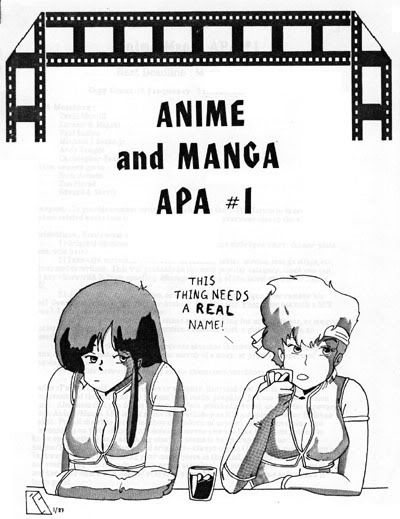
(cover to #1 with art by Paul Sudlow)
For Japanese anime fans in the 80s who wanted to write and draw about their favorite characters, the APA was the way to go. In 1986 a Tennessee undergrad named Paul Sudlow started one with the working title "Anime And Manga APA". This was later changed to the vastly superior "Animanga", a fairly obvious combination of the two words that has since gone on to be used by a wide variety of publications and organizations. But in the beginning it was simply an APA made up of guys (and a few gals) who liked to talk about their favorite Japanese animation.

(cover to #3 with great Rich Arnold art)
ANIMANGA would last for fourteen years, through four different collators ("Offical Editors") and 54 bi-monthly or later quarterly issues of self-published comics, fan art, fan fiction, fan speculation, arguments, political rants, travelogues, sketches, works in progress, video swaps, appropriated works, copyright violations, you name it. Members hailed from the States, Canada, Japan, and points between, and ranged in age from 17 year old punks to 40ish fan veterans, most of whom were way better artists than I was. Some members would go on to direct animated films or successful careers in comics or animation, other members would get married to each other, others would start anime conventions or magazines or drop off the face of the Earth and never be heard from again.
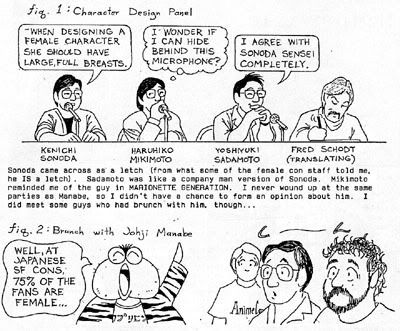
(Animecon 91 report illustrated by David Rains)
There were other anime-themed APAs - U.S.A. Yatsura, Hasshin APA, Sasha APA, Endless Road APA, Starsha APA, Bird Scramble (the Gatchaman APA), even APAs devoted to 'esper' themed anime like JUSTY and LOCKE. But I was in ANIMANGA from beginning to end so that's what I'm writing about.
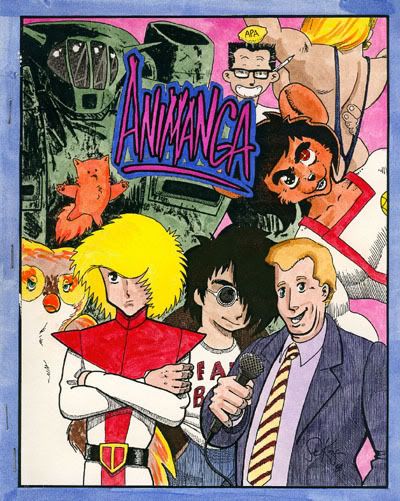
(swell hand-colored cover by Steve Krueger)
APA contributions (or "tribs") varied widely, but a few basics were always there - you'd have a cover or a logo with some kind of cutesy title for your own personal "trib", with contact info so your pals in the APA could call or write when the mood struck them. Imagine doing that on the internet these days! Usually you'd include a segment commenting on the tribs of other members from the previous issue. If you had read their trib and enjoyed it, but didn't have anything in particular to say, you'd just write 'RAEBNC' as shorthand for "read and enjoyed but no comment." The artists among us would try to work up something interesting or unique for the issue - most of the comic artists would either run continuing stories in the APA itself, or use the APA to showcase roughs and ideas for works that were being published elsewhere.

(Andy Temple's Urusei Yatsura fan comics. I loved those things.)
The more accomplished among us would create "how-to" tutorials on lettering, inking, reproduction, and other basics of the comics world. Several fan fiction writers spent their ANIMANGA time serializing their multi-part crossover fanfic epics, and the 'big tent' nature of the fandom of the time meant that your average ANIMANGA would feature anthropomorphic furry adventures, American superhero parody comics, Dr. Who jokes, and Babylon 5 fan art alongside your Dr. Slump drawings and your version of Project A-Ko or your Dirty Pair/Urusei Yatsura crossover fan comic. And if you didn't have anything to say, but couldn't bear to let an issue go by without participating, you'd do the absolute minimum and MINAC ("minimum activity") with just one page saying "sorry, more next time".

(Paul Young draws my "Jet Jaguar" character)
In my mind APAs are part and parcel of the pre-internet days when things were a bit simpler. We didn't have high speed internet, satellite TV, or an anime convention every weekend to constantly demand our attention. The pace of fandom moved slower - many a lazy summer afternoon or rainy day would be spent re-reading APAs or working on your next trib. Fan feuds took months and months to play out in the comments section of APAs, as opposed to the 24 hour blitzkrieg half-life of today's fan fisticuffs.

(JUNKSPACE - original John Ott comics)
And there was always a little tension in the APA - the more traditional American style cartoonists felt threatened by this big-eyed Japanese stuff that was all speed lines and zipatone. The manga style artists felt they were on the cutting edge of what comics SHOULD be. And everybody hated the furries. Members would use ANIMANGA to hash out political philosophies, take jabs at disagreeable aspects of modern culture, or spread malicious fan gossip. Looking back at the APA, it's amazing how seriously we all took this little self-published magazine - pulling all-nighters, spending hundreds of dollars on printing and mailing, all for something that was only going out to 20 or 30 people, tops. I guess that's the nature of fandom - 'fan' is, after all, short for 'fanatic'. In those days there wasn't any time for fence-sitting wishy-washy maybes, it was all or nothing.

(Tim Eldred showcasing some commercial Harlock work)
These days the urge of artists and writers to share their work with the world has been satisfied by dozens of websites devoted to fan art, fan fiction, webcomics and other creative endeavours of all stripes. The societal urge is filled with Livejournals and Myspaces and Facebooks. You can shoot your own movies and share them with the world via YouTube, have your press release blog picked up by Digg or Reddit, and potentially reach millions of people with less trouble than it took us to knock out one APA trib that would be seen by twenty or thirty people, max.
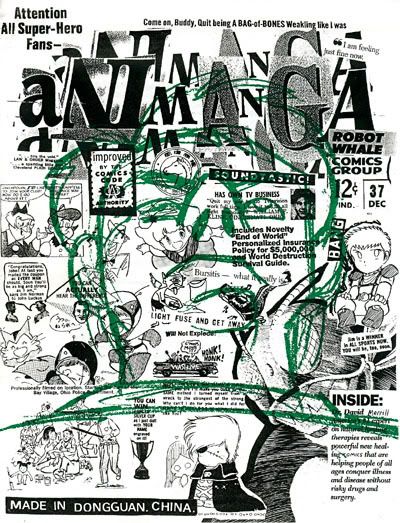
(cut and paste collage cover by me)
This was all just starting to percolate into existence when ANIMANGA took its last bow with issue #54 in 2001; at the time I didn't know what would replace the APA, I just knew that the membership was dwindling and it was getting tougher and tougher to cajole members into actually getting their tribs in on time. Plus, we were all getting older and had jobs. Those of us with creative jobs were finding it harder and harder to spend our leisure time doing what we did all day to pay the rent. Anyway, what ANIMANGA accomplished then is now done in a fraction of the time with a fraction of effort, and the added benefit of not killing any trees.
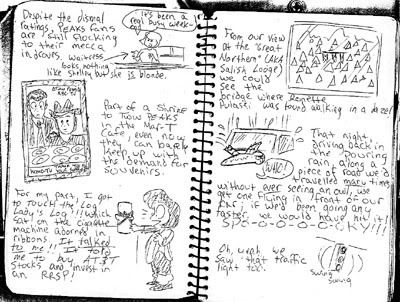
(Twin Peaks travelogue vacation notes by S. M.)
At the same time, I miss the homely circle-of-friends world of the APA. Even if you'd never met any of the members in person, being part of an APA put one in a select group of people whose membership was predicated upon actual participation. We were all struggling to meet deadlines, all working to make the APA bigger and better, and being part of a group like that was kind of inspirational. I think most creative types are more likely to work harder knowing there's an audience reading their work, even if it is a small one, and even if the only response is the eternal RAEBNC.
(all artwork used in this article is copyright the original artists)